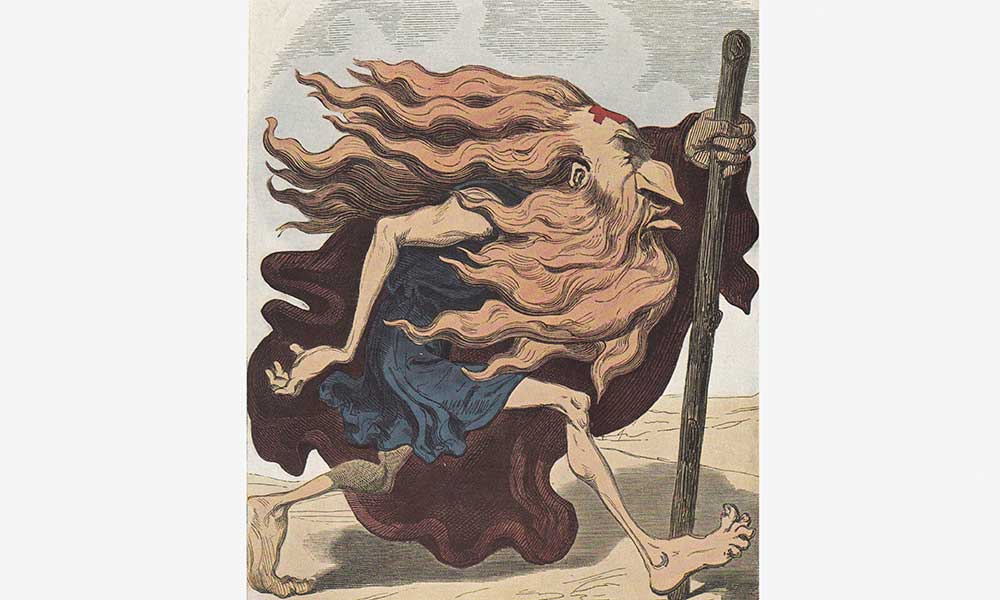This piece originally appeared in Moment in 2010.
Every autumn, Jews all over the world read the Torah portion Lech Lecha, in which God instructs the future patriarch Abraham to abandon his native land for a promised one. In exchange, God vows to make Abraham’s name great and to create a mighty nation out of his descendants. But the 75-year-old isn’t all that pleased when he winds up in Beersheba, a sandy city in the desert prone to famine. Before long, the first Wandering Jew is on the road again, headed to Egypt in search of food.
Be they refugees, merchants or tourists, Jews have been wandering for more than 3,000 years. Yet surprisingly, the origin of the phrase Wandering Jew has little to do with peripatetic Semites. Instead, it harks back to a fictitious—and anti-Semitic—legend that arose in late antiquity.
Sometime between the 3rd and 7th centuries, a story began circulating about a Jew who had refused to allow Jesus to lean against the wall of his house as he carried the cross to the crucifixion, according to Galit Hasan-Rokem, professor of folklore at Hebrew University in Jerusalem. In later versions, the Jew is said to verbally assault Jesus or even strike him. Whatever the details, says Hasan-Rokem, in each telling the Jew “was cursed by Jesus to wander until the Second Coming.”
Although it first emerged in written form in 13th-century Italy, the tale didn’t become popular until 1602, when it was recorded in a German book, A Brief Description and Narrative Regarding a Jew Named Ahasuerus. The author asserted that the bishop of a town called Schleswig had encountered a Jew named Ahasuerus in Hamburg in the 1540s; Ahasuerus told the bishop that he had been wandering aimlessly for well over 1,000 years.
The book became a bestseller with more than 80 printings over the next century—“like an Oprah’s pick, back when there wasn’t much to pick from,” says Joanna Brichetto, who wrote her master’s thesis at Vanderbilt University on images of the Wandering Jew. Soon the Wandering Jew was featured prominently in English, French and Finnish ballads and even crept into literature and art.
“And here am I a-walkin’ about like the wanderin’ Jew—a sportin’ character you have perhaps heerd on,” wrote Charles Dickens in his serial 1836-37 novel The Pickwick Papers. Twenty years later, the French artist Gustave Doré illustrated Pierre-Jean de Béranger’s “La Légende du Juif Errant”—images that Brichetto calls the “definitive representation of the anti-Jewish Wandering Jew.” By the end of the 19th century, “all of Europe…was on a first-name basis with Ahasuerus,” she wrote in her thesis. He was generally portrayed as devilish and money-grubbing; he bore a facial blemish and a heavy, tangled beard, and was equipped with a walking stick and purse.
Serving as “a common target for any and all Judenhass [Jew hatred],” Ahasuerus “enjoyed a burst of popularity” between 1890 and 1920 in Germany, says Brichetto. Der Ewige Jude—the Eternal Jew—as the Germans called him, “was as likely to turn up in a third-rate novella as in a satirical cartoon or political diatribe.”
At the same time, Jews—largely in response to the racism—began to claim the Wandering Jew as their own. In certain circles, Hasan-Rokem explains, he had already become “identified with the positive values of individualism, rebellion against religious authorities and authority in general.” Hasan-Rokem offers the example of James Joyce’s Ulysses, which “combines Europe’s two great wanderers: Odysseus and the Wandering Jew.”
Jewish painters such as Marc Chagall and Samuel Hirszenberg, too, were drawn to the character. In 1899, Hirszenberg painted his Wandering Jew, an apocalyptic image in which a Jesus-like figure is represented as “a desperate, old Polish Jew whose suffering saves no one,” says Brichetto. Chagall’s Jews came to represent “the quintessential Wandering Jews of the 20th century, reflecting political and existential exile.”
Not surprisingly, Nazis resurrected the Wandering Jew to portray Jews as cultural parasites whose values and character traits ran counter to the Aryan ideal. But although the figure continues to function as a catalyst of hate, appearing, for example, on neo-Nazi websites, its original meaning has begun to recede into history. A wanderer, after all, is not necessarily a negative thing or even uniquely Jewish. “There is no single archetypal figure,” says Jay Geller, professor of modern Jewish culture at Vanderbilt University, who explains that there are also non-Jewish variants such as the Flying Dutchman and the Ancient Mariner.
Today the term is popular with Jewish travelers and travel writers, which Brichetto applauds. She believes it’s important for Jews to continue to imbue the Wandering Jew with positive meanings in order to counter its ugly past. “We should use it,” says Brichetto, “but we should always question it: Who is using the term and why?”
Moment Magazine participates in the Amazon Associates program and earns money from qualifying purchases.

